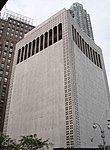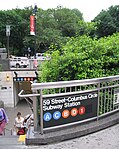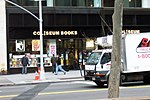2 Columbus Circle

2 Columbus Circle is a 12-story building located on a small trapezoidal lot on the south side of Columbus Circle on the Upper West Side of Manhattan, New York City. Bordered by 58th Street, 59th Street, Broadway, and Eighth Avenue, it stands on the site of the former seven-story Grand Circle Hotel. It opened in 1964, after A&P heir Huntington Hartford hired architect Edward Durell Stone to build a museum for him at the site. Controversy was sparked in 2002 after the Museum of Arts and Design (MAD) purchased the building and planned to significantly alter its design, including modifying its facade. Calls had been made since 1996 for the building to be landmarked, so its proposed landmark status was brought into question with this renovation. The renovations were completed in 2008.
Excerpt from the Wikipedia article 2 Columbus Circle (License: CC BY-SA 3.0, Authors, Images).2 Columbus Circle
Columbus Circle, New York Manhattan
Geographical coordinates (GPS) Address Phone number Website External links Nearby Places Show on map
Geographical coordinates (GPS)
| Latitude | Longitude |
|---|---|
| N 40.767361111111 ° | E -73.981944444444 ° |
Address
Museum of Arts and Design
Columbus Circle 2
10023 New York, Manhattan
New York, United States
Open on Google Maps







